A Report on Economics for Less Developed Nations: Analysis and Trends
VerifiedAdded on 2022/08/27
|12
|1692
|13
Report
AI Summary
This report provides an economic analysis of less developed nations, using Turkey as a case study. It examines demographic transitions, including birth and death rates, and the impact of infant mortality. The report explores population and fertility choices, analyzing marginal benefits and costs, and the impact of externalities on family size. Structural transformation trends, such as urbanization and changes in agricultural employment, are discussed. The study also investigates the relationship between income, migration, and commodity price shocks, offering insights into the factors influencing emigration and the potential effects of rural development investments. The report utilizes data from the World Bank and other sources to support its findings and includes a discussion of relevant economic concepts and theories.
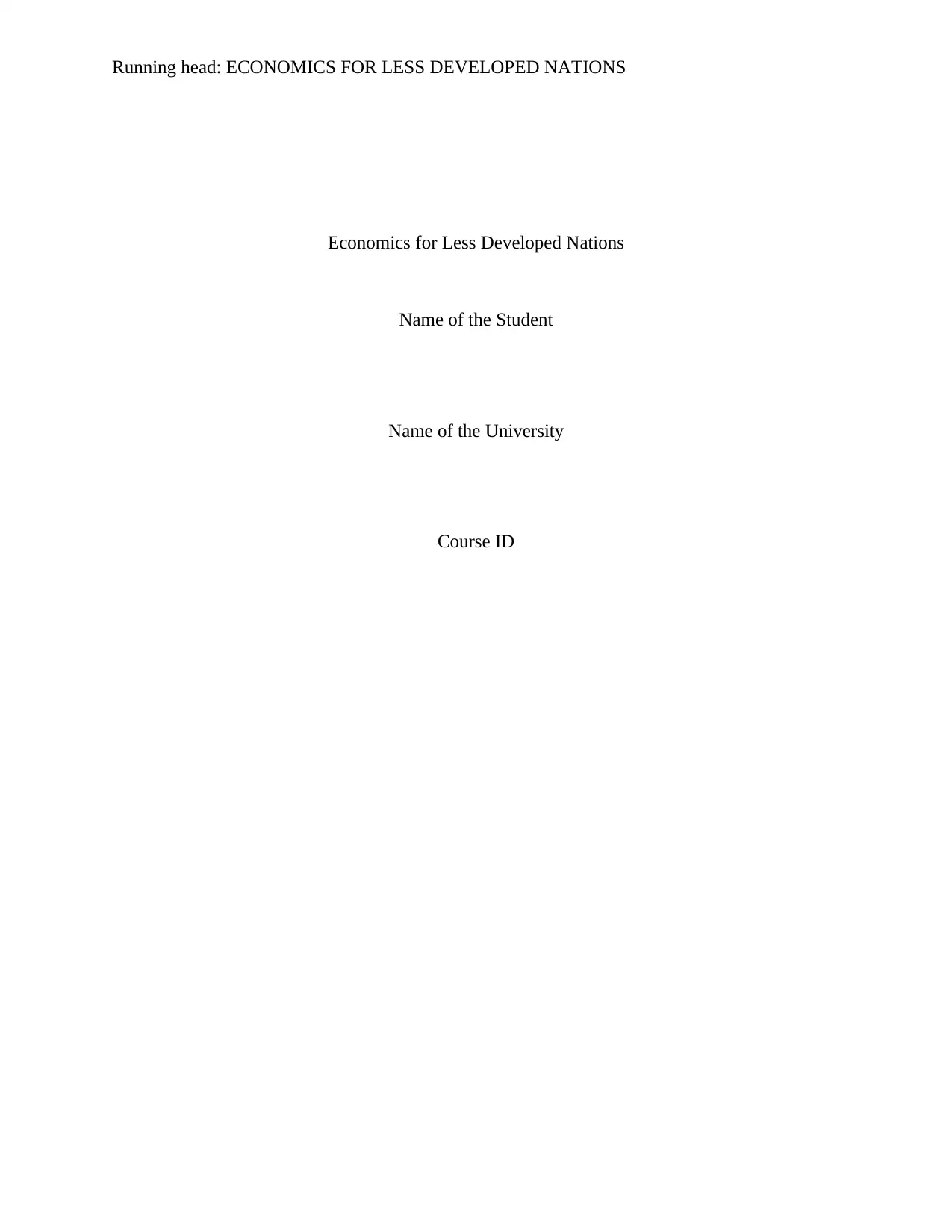
Running head: ECONOMICS FOR LESS DEVELOPED NATIONS
Economics for Less Developed Nations
Name of the Student
Name of the University
Course ID
Economics for Less Developed Nations
Name of the Student
Name of the University
Course ID
Paraphrase This Document
Need a fresh take? Get an instant paraphrase of this document with our AI Paraphraser
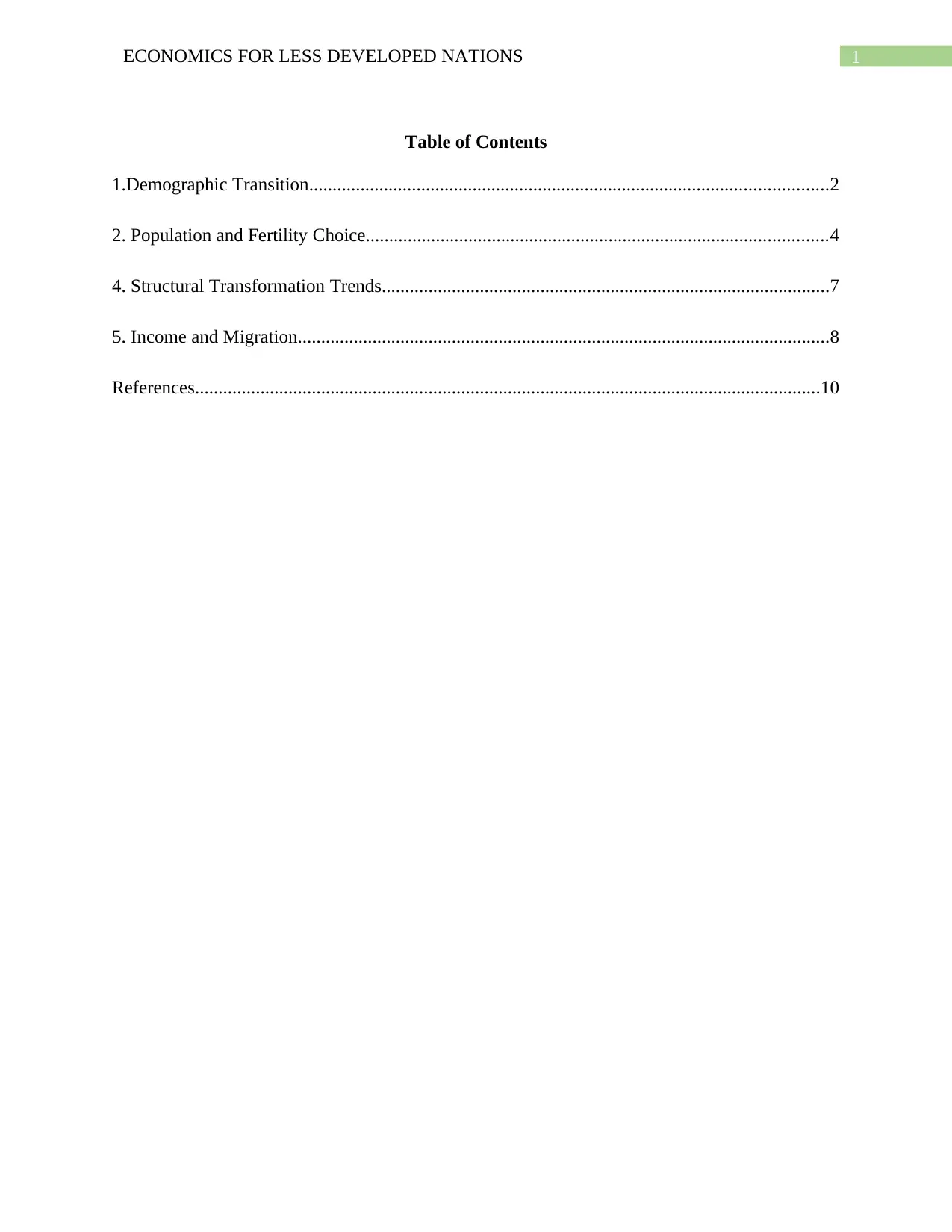
1ECONOMICS FOR LESS DEVELOPED NATIONS
Table of Contents
1.Demographic Transition...............................................................................................................2
2. Population and Fertility Choice...................................................................................................4
4. Structural Transformation Trends................................................................................................7
5. Income and Migration..................................................................................................................8
References......................................................................................................................................10
Table of Contents
1.Demographic Transition...............................................................................................................2
2. Population and Fertility Choice...................................................................................................4
4. Structural Transformation Trends................................................................................................7
5. Income and Migration..................................................................................................................8
References......................................................................................................................................10
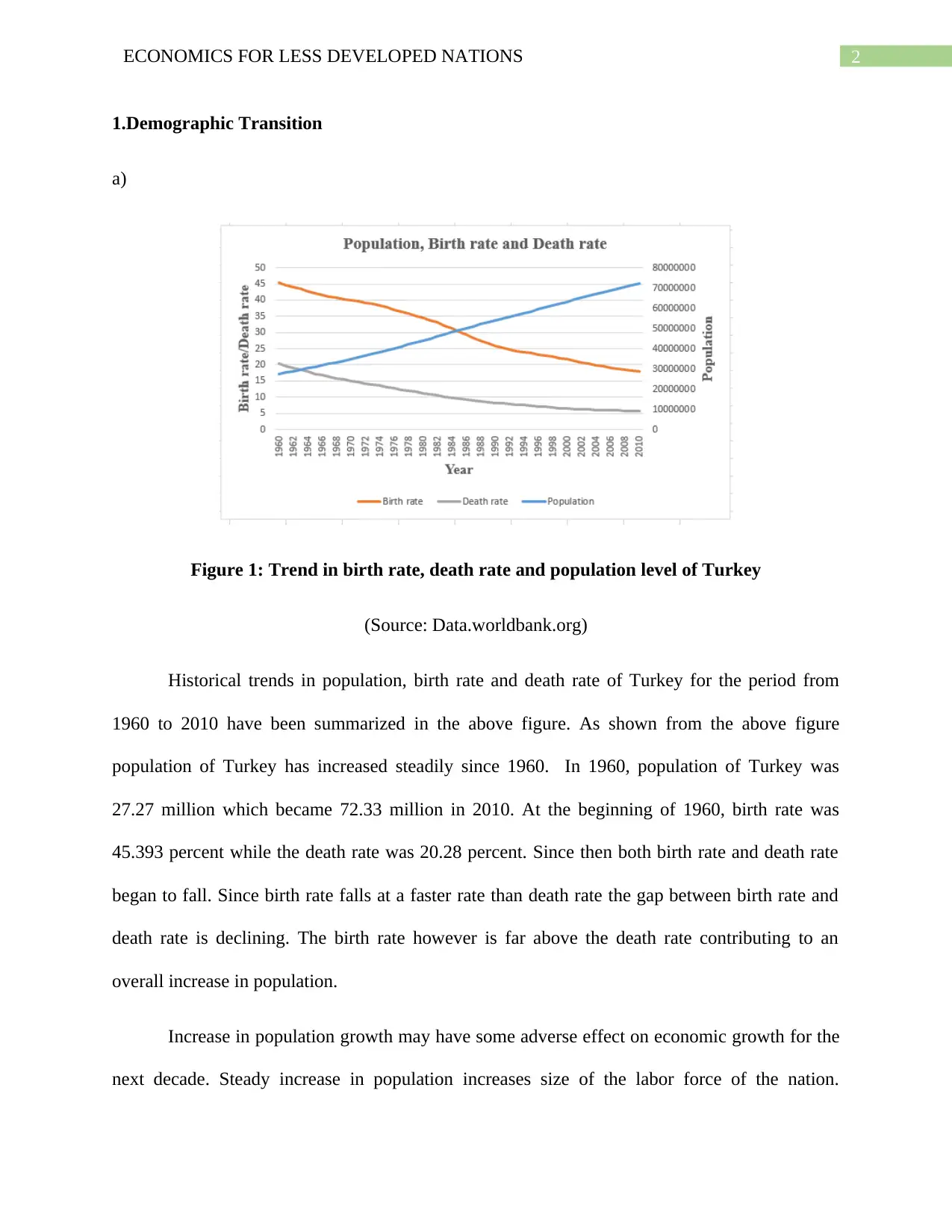
2ECONOMICS FOR LESS DEVELOPED NATIONS
1.Demographic Transition
a)
Figure 1: Trend in birth rate, death rate and population level of Turkey
(Source: Data.worldbank.org)
Historical trends in population, birth rate and death rate of Turkey for the period from
1960 to 2010 have been summarized in the above figure. As shown from the above figure
population of Turkey has increased steadily since 1960. In 1960, population of Turkey was
27.27 million which became 72.33 million in 2010. At the beginning of 1960, birth rate was
45.393 percent while the death rate was 20.28 percent. Since then both birth rate and death rate
began to fall. Since birth rate falls at a faster rate than death rate the gap between birth rate and
death rate is declining. The birth rate however is far above the death rate contributing to an
overall increase in population.
Increase in population growth may have some adverse effect on economic growth for the
next decade. Steady increase in population increases size of the labor force of the nation.
1.Demographic Transition
a)
Figure 1: Trend in birth rate, death rate and population level of Turkey
(Source: Data.worldbank.org)
Historical trends in population, birth rate and death rate of Turkey for the period from
1960 to 2010 have been summarized in the above figure. As shown from the above figure
population of Turkey has increased steadily since 1960. In 1960, population of Turkey was
27.27 million which became 72.33 million in 2010. At the beginning of 1960, birth rate was
45.393 percent while the death rate was 20.28 percent. Since then both birth rate and death rate
began to fall. Since birth rate falls at a faster rate than death rate the gap between birth rate and
death rate is declining. The birth rate however is far above the death rate contributing to an
overall increase in population.
Increase in population growth may have some adverse effect on economic growth for the
next decade. Steady increase in population increases size of the labor force of the nation.
⊘ This is a preview!⊘
Do you want full access?
Subscribe today to unlock all pages.

Trusted by 1+ million students worldwide
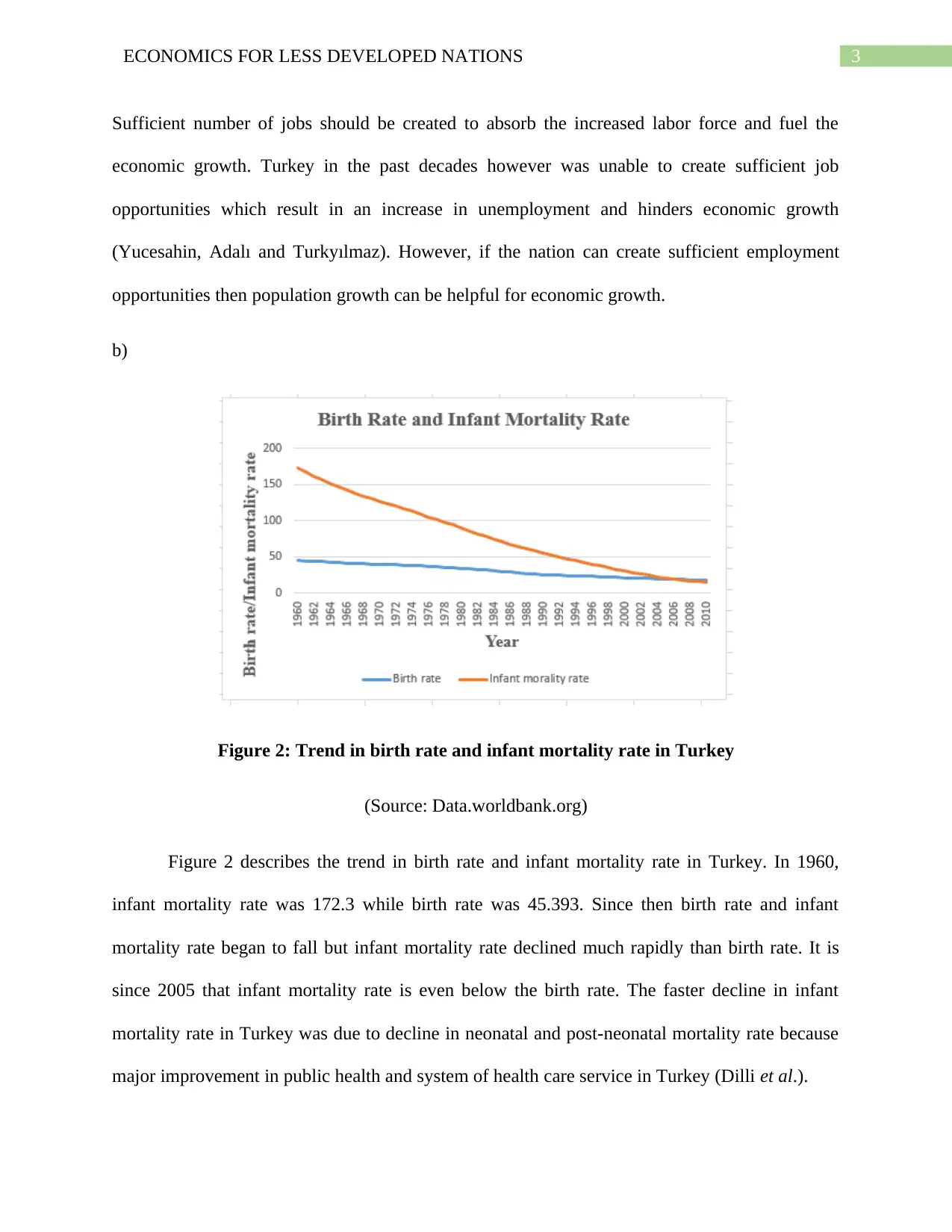
3ECONOMICS FOR LESS DEVELOPED NATIONS
Sufficient number of jobs should be created to absorb the increased labor force and fuel the
economic growth. Turkey in the past decades however was unable to create sufficient job
opportunities which result in an increase in unemployment and hinders economic growth
(Yucesahin, Adalı and Turkyılmaz). However, if the nation can create sufficient employment
opportunities then population growth can be helpful for economic growth.
b)
Figure 2: Trend in birth rate and infant mortality rate in Turkey
(Source: Data.worldbank.org)
Figure 2 describes the trend in birth rate and infant mortality rate in Turkey. In 1960,
infant mortality rate was 172.3 while birth rate was 45.393. Since then birth rate and infant
mortality rate began to fall but infant mortality rate declined much rapidly than birth rate. It is
since 2005 that infant mortality rate is even below the birth rate. The faster decline in infant
mortality rate in Turkey was due to decline in neonatal and post-neonatal mortality rate because
major improvement in public health and system of health care service in Turkey (Dilli et al.).
Sufficient number of jobs should be created to absorb the increased labor force and fuel the
economic growth. Turkey in the past decades however was unable to create sufficient job
opportunities which result in an increase in unemployment and hinders economic growth
(Yucesahin, Adalı and Turkyılmaz). However, if the nation can create sufficient employment
opportunities then population growth can be helpful for economic growth.
b)
Figure 2: Trend in birth rate and infant mortality rate in Turkey
(Source: Data.worldbank.org)
Figure 2 describes the trend in birth rate and infant mortality rate in Turkey. In 1960,
infant mortality rate was 172.3 while birth rate was 45.393. Since then birth rate and infant
mortality rate began to fall but infant mortality rate declined much rapidly than birth rate. It is
since 2005 that infant mortality rate is even below the birth rate. The faster decline in infant
mortality rate in Turkey was due to decline in neonatal and post-neonatal mortality rate because
major improvement in public health and system of health care service in Turkey (Dilli et al.).
Paraphrase This Document
Need a fresh take? Get an instant paraphrase of this document with our AI Paraphraser

4ECONOMICS FOR LESS DEVELOPED NATIONS
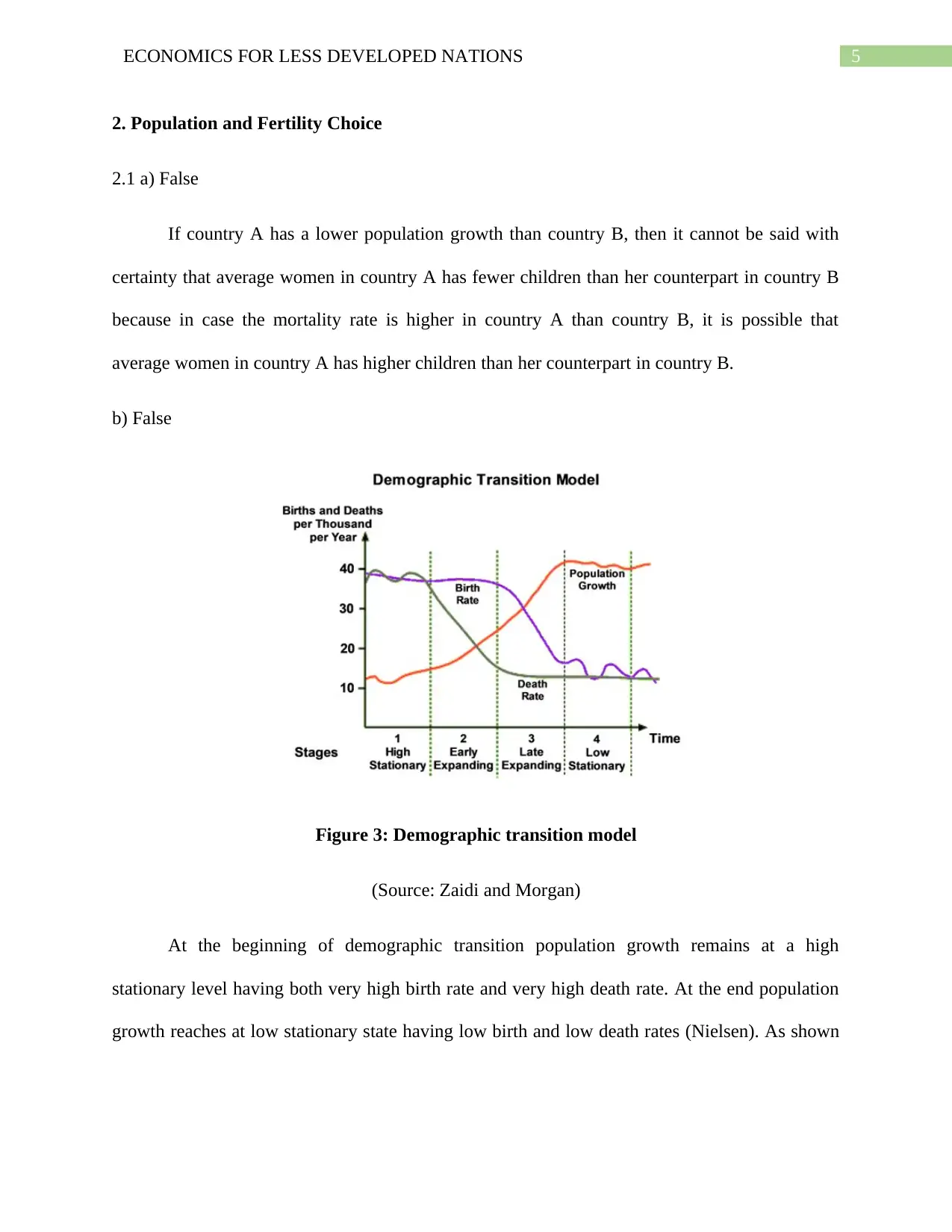
5ECONOMICS FOR LESS DEVELOPED NATIONS
2. Population and Fertility Choice
2.1 a) False
If country A has a lower population growth than country B, then it cannot be said with
certainty that average women in country A has fewer children than her counterpart in country B
because in case the mortality rate is higher in country A than country B, it is possible that
average women in country A has higher children than her counterpart in country B.
b) False
Figure 3: Demographic transition model
(Source: Zaidi and Morgan)
At the beginning of demographic transition population growth remains at a high
stationary level having both very high birth rate and very high death rate. At the end population
growth reaches at low stationary state having low birth and low death rates (Nielsen). As shown
2. Population and Fertility Choice
2.1 a) False
If country A has a lower population growth than country B, then it cannot be said with
certainty that average women in country A has fewer children than her counterpart in country B
because in case the mortality rate is higher in country A than country B, it is possible that
average women in country A has higher children than her counterpart in country B.
b) False
Figure 3: Demographic transition model
(Source: Zaidi and Morgan)
At the beginning of demographic transition population growth remains at a high
stationary level having both very high birth rate and very high death rate. At the end population
growth reaches at low stationary state having low birth and low death rates (Nielsen). As shown
⊘ This is a preview!⊘
Do you want full access?
Subscribe today to unlock all pages.

Trusted by 1+ million students worldwide
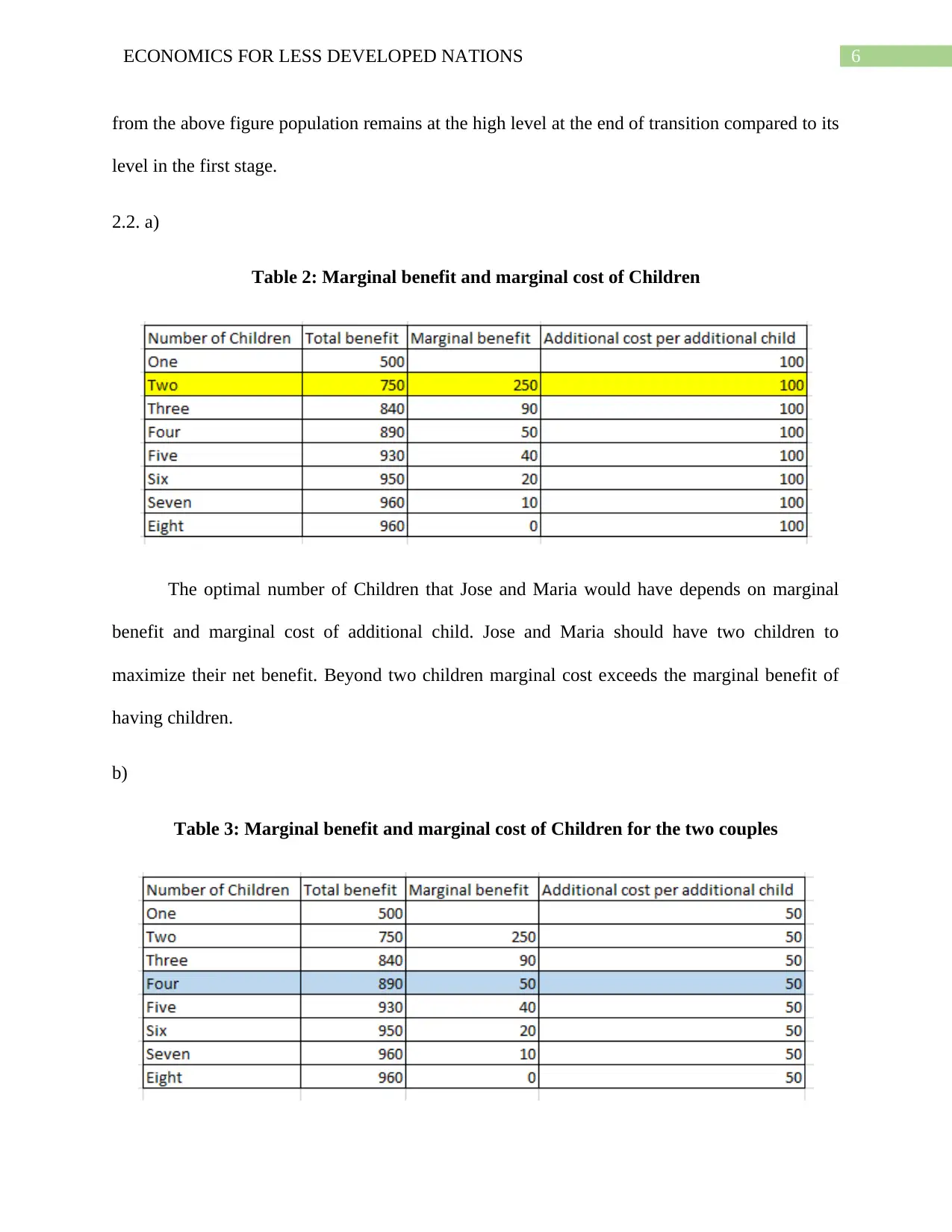
6ECONOMICS FOR LESS DEVELOPED NATIONS
from the above figure population remains at the high level at the end of transition compared to its
level in the first stage.
2.2. a)
Table 2: Marginal benefit and marginal cost of Children
The optimal number of Children that Jose and Maria would have depends on marginal
benefit and marginal cost of additional child. Jose and Maria should have two children to
maximize their net benefit. Beyond two children marginal cost exceeds the marginal benefit of
having children.
b)
Table 3: Marginal benefit and marginal cost of Children for the two couples
from the above figure population remains at the high level at the end of transition compared to its
level in the first stage.
2.2. a)
Table 2: Marginal benefit and marginal cost of Children
The optimal number of Children that Jose and Maria would have depends on marginal
benefit and marginal cost of additional child. Jose and Maria should have two children to
maximize their net benefit. Beyond two children marginal cost exceeds the marginal benefit of
having children.
b)
Table 3: Marginal benefit and marginal cost of Children for the two couples
Paraphrase This Document
Need a fresh take? Get an instant paraphrase of this document with our AI Paraphraser
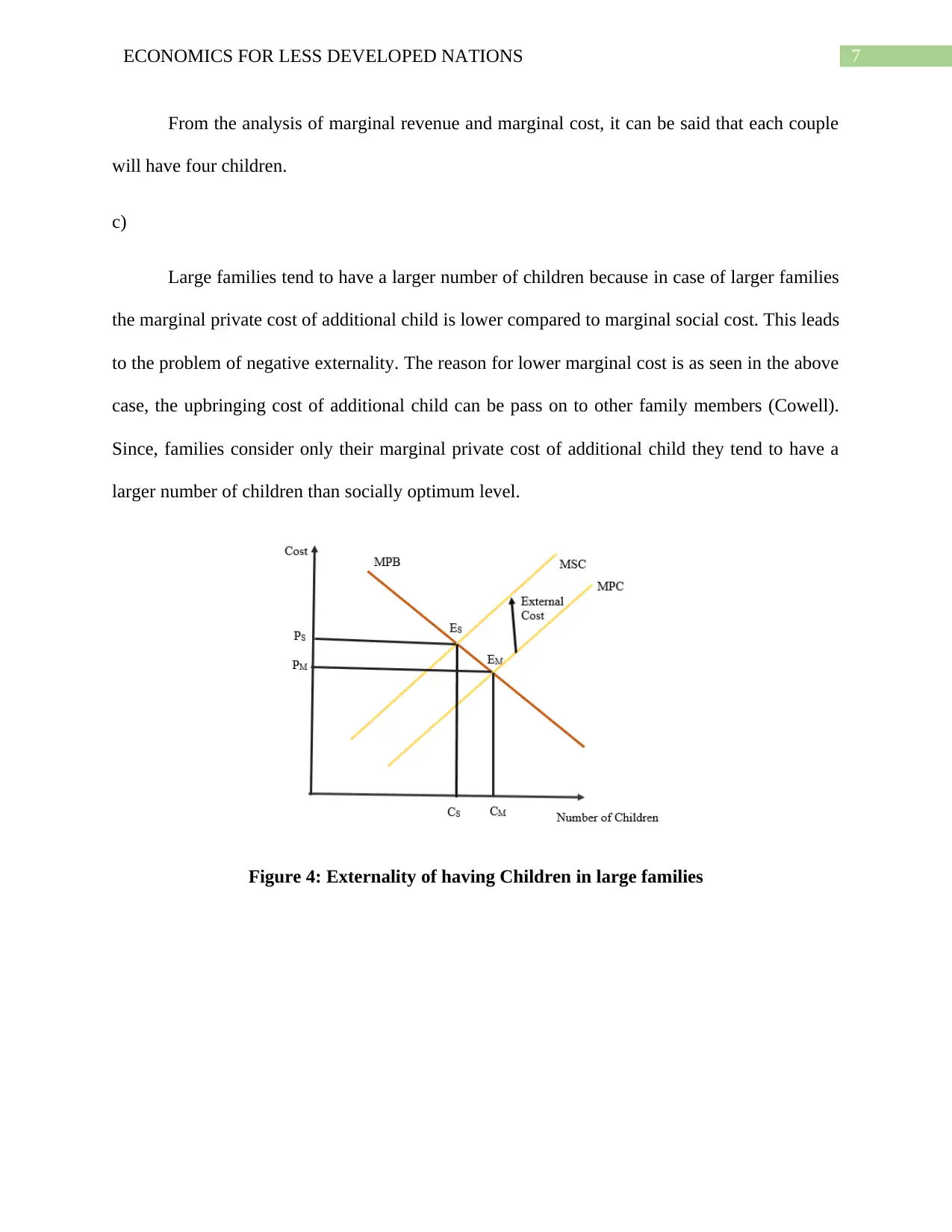
7ECONOMICS FOR LESS DEVELOPED NATIONS
From the analysis of marginal revenue and marginal cost, it can be said that each couple
will have four children.
c)
Large families tend to have a larger number of children because in case of larger families
the marginal private cost of additional child is lower compared to marginal social cost. This leads
to the problem of negative externality. The reason for lower marginal cost is as seen in the above
case, the upbringing cost of additional child can be pass on to other family members (Cowell).
Since, families consider only their marginal private cost of additional child they tend to have a
larger number of children than socially optimum level.
Figure 4: Externality of having Children in large families
From the analysis of marginal revenue and marginal cost, it can be said that each couple
will have four children.
c)
Large families tend to have a larger number of children because in case of larger families
the marginal private cost of additional child is lower compared to marginal social cost. This leads
to the problem of negative externality. The reason for lower marginal cost is as seen in the above
case, the upbringing cost of additional child can be pass on to other family members (Cowell).
Since, families consider only their marginal private cost of additional child they tend to have a
larger number of children than socially optimum level.
Figure 4: Externality of having Children in large families
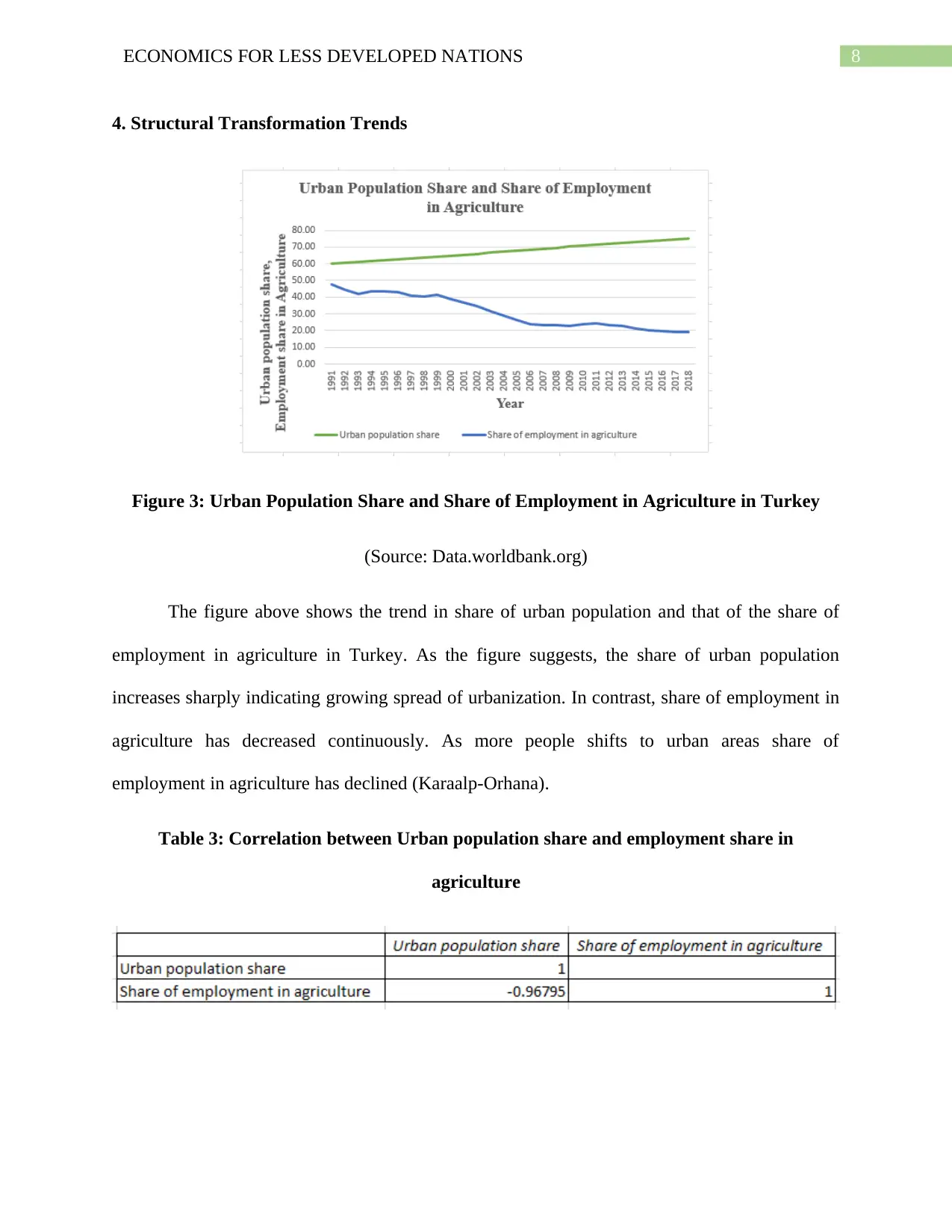
8ECONOMICS FOR LESS DEVELOPED NATIONS
4. Structural Transformation Trends
Figure 3: Urban Population Share and Share of Employment in Agriculture in Turkey
(Source: Data.worldbank.org)
The figure above shows the trend in share of urban population and that of the share of
employment in agriculture in Turkey. As the figure suggests, the share of urban population
increases sharply indicating growing spread of urbanization. In contrast, share of employment in
agriculture has decreased continuously. As more people shifts to urban areas share of
employment in agriculture has declined (Karaalp-Orhana).
Table 3: Correlation between Urban population share and employment share in
agriculture
4. Structural Transformation Trends
Figure 3: Urban Population Share and Share of Employment in Agriculture in Turkey
(Source: Data.worldbank.org)
The figure above shows the trend in share of urban population and that of the share of
employment in agriculture in Turkey. As the figure suggests, the share of urban population
increases sharply indicating growing spread of urbanization. In contrast, share of employment in
agriculture has decreased continuously. As more people shifts to urban areas share of
employment in agriculture has declined (Karaalp-Orhana).
Table 3: Correlation between Urban population share and employment share in
agriculture
⊘ This is a preview!⊘
Do you want full access?
Subscribe today to unlock all pages.

Trusted by 1+ million students worldwide
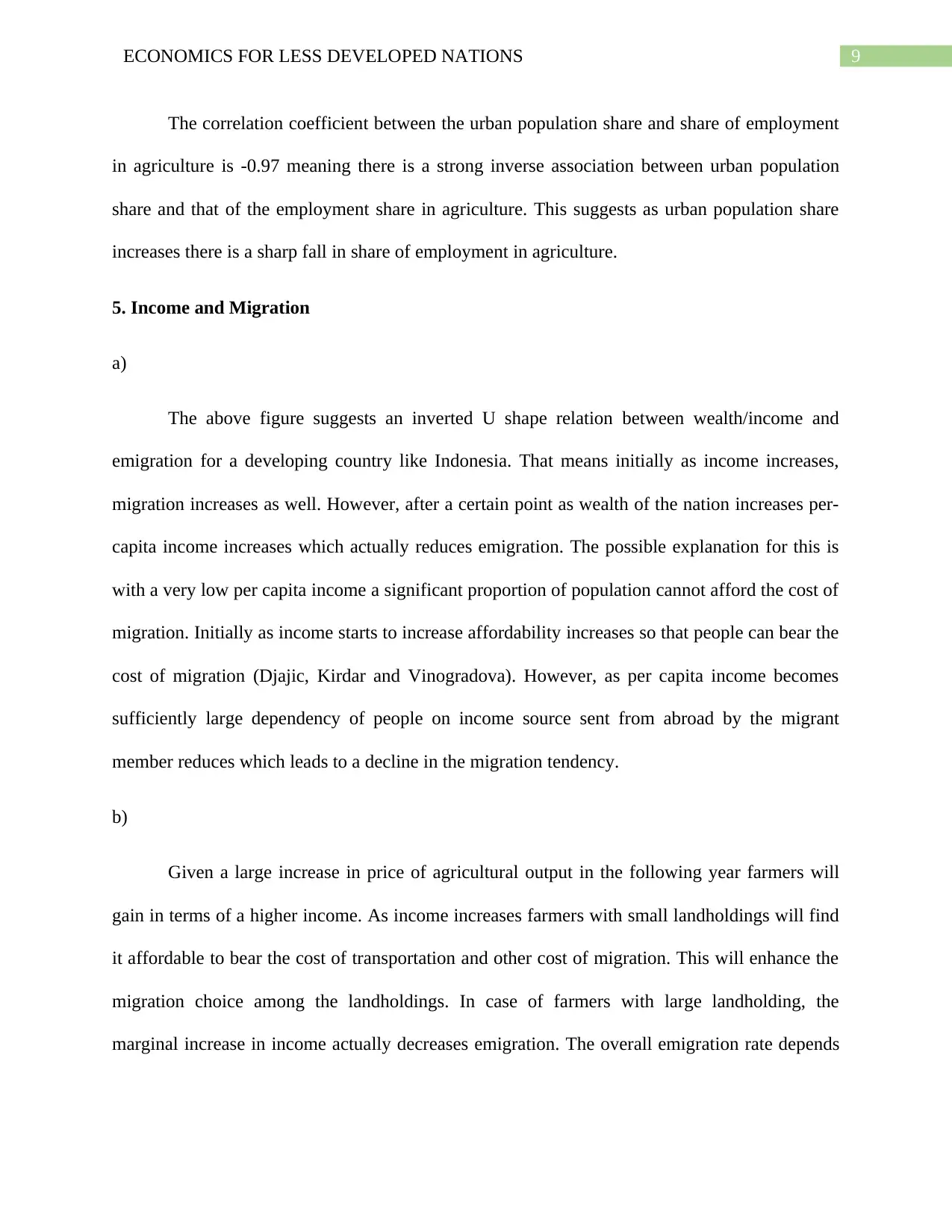
9ECONOMICS FOR LESS DEVELOPED NATIONS
The correlation coefficient between the urban population share and share of employment
in agriculture is -0.97 meaning there is a strong inverse association between urban population
share and that of the employment share in agriculture. This suggests as urban population share
increases there is a sharp fall in share of employment in agriculture.
5. Income and Migration
a)
The above figure suggests an inverted U shape relation between wealth/income and
emigration for a developing country like Indonesia. That means initially as income increases,
migration increases as well. However, after a certain point as wealth of the nation increases per-
capita income increases which actually reduces emigration. The possible explanation for this is
with a very low per capita income a significant proportion of population cannot afford the cost of
migration. Initially as income starts to increase affordability increases so that people can bear the
cost of migration (Djajic, Kirdar and Vinogradova). However, as per capita income becomes
sufficiently large dependency of people on income source sent from abroad by the migrant
member reduces which leads to a decline in the migration tendency.
b)
Given a large increase in price of agricultural output in the following year farmers will
gain in terms of a higher income. As income increases farmers with small landholdings will find
it affordable to bear the cost of transportation and other cost of migration. This will enhance the
migration choice among the landholdings. In case of farmers with large landholding, the
marginal increase in income actually decreases emigration. The overall emigration rate depends
The correlation coefficient between the urban population share and share of employment
in agriculture is -0.97 meaning there is a strong inverse association between urban population
share and that of the employment share in agriculture. This suggests as urban population share
increases there is a sharp fall in share of employment in agriculture.
5. Income and Migration
a)
The above figure suggests an inverted U shape relation between wealth/income and
emigration for a developing country like Indonesia. That means initially as income increases,
migration increases as well. However, after a certain point as wealth of the nation increases per-
capita income increases which actually reduces emigration. The possible explanation for this is
with a very low per capita income a significant proportion of population cannot afford the cost of
migration. Initially as income starts to increase affordability increases so that people can bear the
cost of migration (Djajic, Kirdar and Vinogradova). However, as per capita income becomes
sufficiently large dependency of people on income source sent from abroad by the migrant
member reduces which leads to a decline in the migration tendency.
b)
Given a large increase in price of agricultural output in the following year farmers will
gain in terms of a higher income. As income increases farmers with small landholdings will find
it affordable to bear the cost of transportation and other cost of migration. This will enhance the
migration choice among the landholdings. In case of farmers with large landholding, the
marginal increase in income actually decreases emigration. The overall emigration rate depends
Paraphrase This Document
Need a fresh take? Get an instant paraphrase of this document with our AI Paraphraser
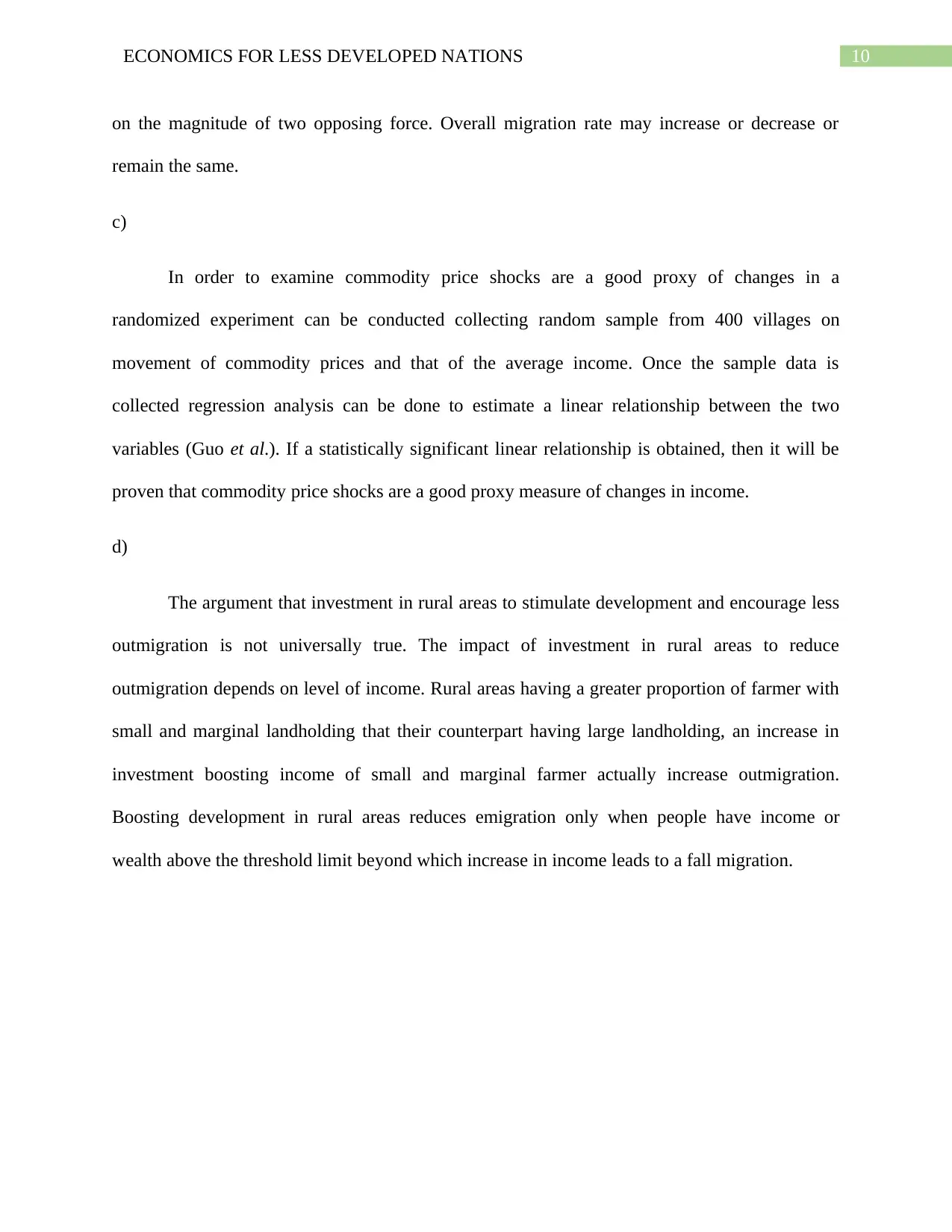
10ECONOMICS FOR LESS DEVELOPED NATIONS
on the magnitude of two opposing force. Overall migration rate may increase or decrease or
remain the same.
c)
In order to examine commodity price shocks are a good proxy of changes in a
randomized experiment can be conducted collecting random sample from 400 villages on
movement of commodity prices and that of the average income. Once the sample data is
collected regression analysis can be done to estimate a linear relationship between the two
variables (Guo et al.). If a statistically significant linear relationship is obtained, then it will be
proven that commodity price shocks are a good proxy measure of changes in income.
d)
The argument that investment in rural areas to stimulate development and encourage less
outmigration is not universally true. The impact of investment in rural areas to reduce
outmigration depends on level of income. Rural areas having a greater proportion of farmer with
small and marginal landholding that their counterpart having large landholding, an increase in
investment boosting income of small and marginal farmer actually increase outmigration.
Boosting development in rural areas reduces emigration only when people have income or
wealth above the threshold limit beyond which increase in income leads to a fall migration.
on the magnitude of two opposing force. Overall migration rate may increase or decrease or
remain the same.
c)
In order to examine commodity price shocks are a good proxy of changes in a
randomized experiment can be conducted collecting random sample from 400 villages on
movement of commodity prices and that of the average income. Once the sample data is
collected regression analysis can be done to estimate a linear relationship between the two
variables (Guo et al.). If a statistically significant linear relationship is obtained, then it will be
proven that commodity price shocks are a good proxy measure of changes in income.
d)
The argument that investment in rural areas to stimulate development and encourage less
outmigration is not universally true. The impact of investment in rural areas to reduce
outmigration depends on level of income. Rural areas having a greater proportion of farmer with
small and marginal landholding that their counterpart having large landholding, an increase in
investment boosting income of small and marginal farmer actually increase outmigration.
Boosting development in rural areas reduces emigration only when people have income or
wealth above the threshold limit beyond which increase in income leads to a fall migration.
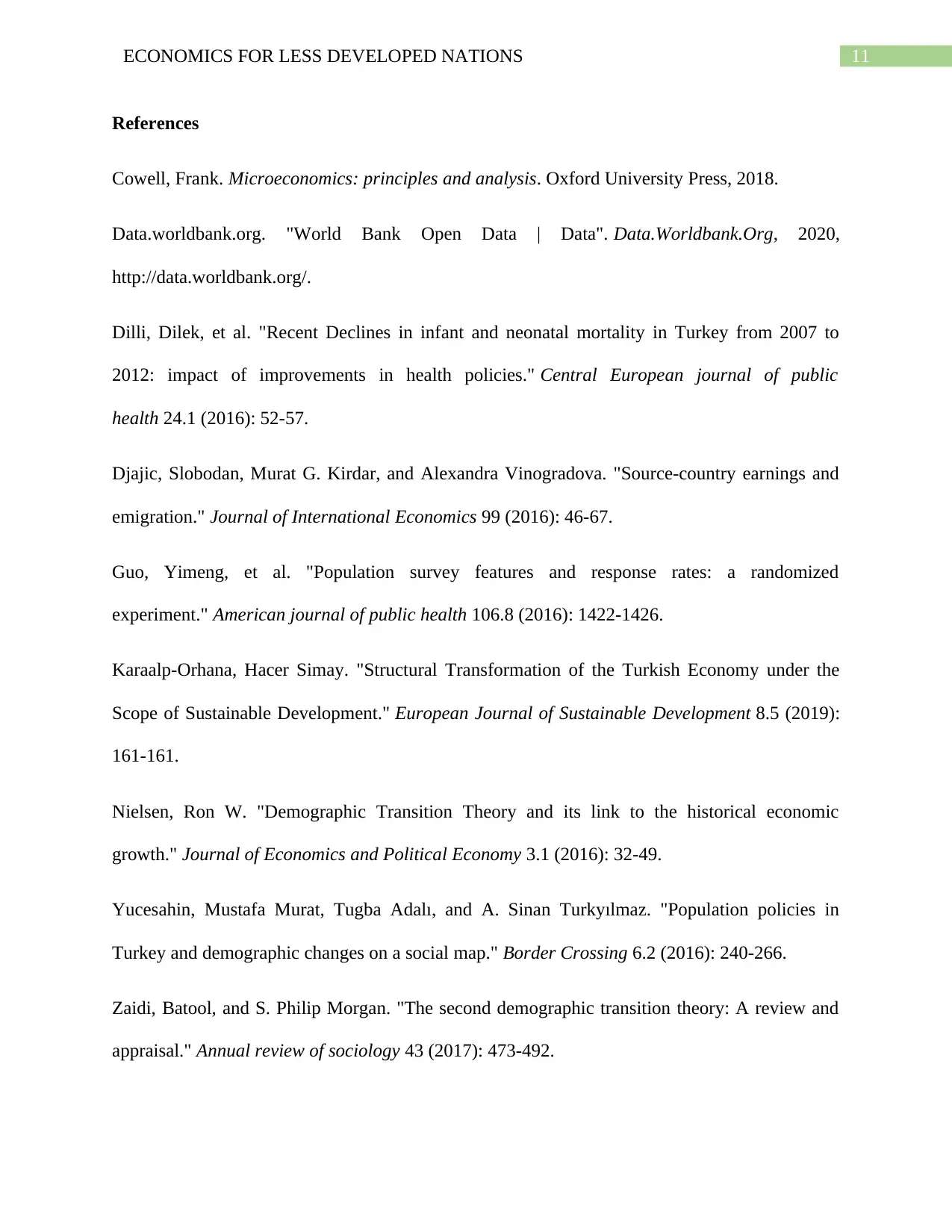
11ECONOMICS FOR LESS DEVELOPED NATIONS
References
Cowell, Frank. Microeconomics: principles and analysis. Oxford University Press, 2018.
Data.worldbank.org. "World Bank Open Data | Data". Data.Worldbank.Org, 2020,
http://data.worldbank.org/.
Dilli, Dilek, et al. "Recent Declines in infant and neonatal mortality in Turkey from 2007 to
2012: impact of improvements in health policies." Central European journal of public
health 24.1 (2016): 52-57.
Djajic, Slobodan, Murat G. Kirdar, and Alexandra Vinogradova. "Source-country earnings and
emigration." Journal of International Economics 99 (2016): 46-67.
Guo, Yimeng, et al. "Population survey features and response rates: a randomized
experiment." American journal of public health 106.8 (2016): 1422-1426.
Karaalp-Orhana, Hacer Simay. "Structural Transformation of the Turkish Economy under the
Scope of Sustainable Development." European Journal of Sustainable Development 8.5 (2019):
161-161.
Nielsen, Ron W. "Demographic Transition Theory and its link to the historical economic
growth." Journal of Economics and Political Economy 3.1 (2016): 32-49.
Yucesahin, Mustafa Murat, Tugba Adalı, and A. Sinan Turkyılmaz. "Population policies in
Turkey and demographic changes on a social map." Border Crossing 6.2 (2016): 240-266.
Zaidi, Batool, and S. Philip Morgan. "The second demographic transition theory: A review and
appraisal." Annual review of sociology 43 (2017): 473-492.
References
Cowell, Frank. Microeconomics: principles and analysis. Oxford University Press, 2018.
Data.worldbank.org. "World Bank Open Data | Data". Data.Worldbank.Org, 2020,
http://data.worldbank.org/.
Dilli, Dilek, et al. "Recent Declines in infant and neonatal mortality in Turkey from 2007 to
2012: impact of improvements in health policies." Central European journal of public
health 24.1 (2016): 52-57.
Djajic, Slobodan, Murat G. Kirdar, and Alexandra Vinogradova. "Source-country earnings and
emigration." Journal of International Economics 99 (2016): 46-67.
Guo, Yimeng, et al. "Population survey features and response rates: a randomized
experiment." American journal of public health 106.8 (2016): 1422-1426.
Karaalp-Orhana, Hacer Simay. "Structural Transformation of the Turkish Economy under the
Scope of Sustainable Development." European Journal of Sustainable Development 8.5 (2019):
161-161.
Nielsen, Ron W. "Demographic Transition Theory and its link to the historical economic
growth." Journal of Economics and Political Economy 3.1 (2016): 32-49.
Yucesahin, Mustafa Murat, Tugba Adalı, and A. Sinan Turkyılmaz. "Population policies in
Turkey and demographic changes on a social map." Border Crossing 6.2 (2016): 240-266.
Zaidi, Batool, and S. Philip Morgan. "The second demographic transition theory: A review and
appraisal." Annual review of sociology 43 (2017): 473-492.
⊘ This is a preview!⊘
Do you want full access?
Subscribe today to unlock all pages.

Trusted by 1+ million students worldwide
1 out of 12
Related Documents
Your All-in-One AI-Powered Toolkit for Academic Success.
+13062052269
info@desklib.com
Available 24*7 on WhatsApp / Email
![[object Object]](/_next/static/media/star-bottom.7253800d.svg)
Unlock your academic potential
Copyright © 2020–2025 A2Z Services. All Rights Reserved. Developed and managed by ZUCOL.





